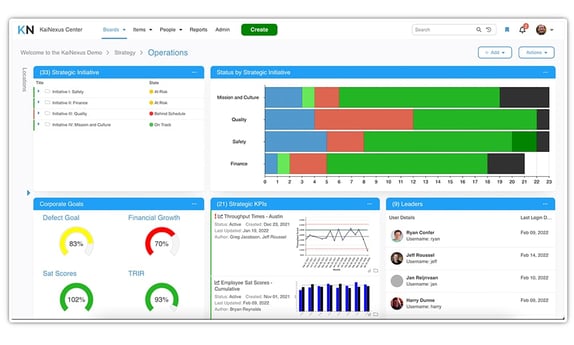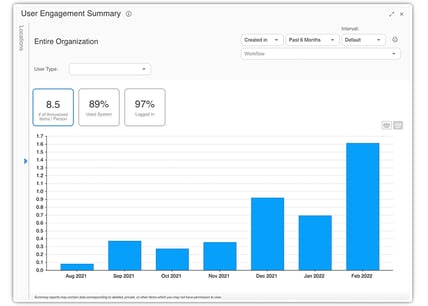 For many companies, 2020 will be the year they implement digital continuous improvement. If your organization has decided to do that or is considering doing so, congratulations! We know from the considerable experience of our clients that implementing improvement technology can lead to more completed projects with a more significant impact.
For many companies, 2020 will be the year they implement digital continuous improvement. If your organization has decided to do that or is considering doing so, congratulations! We know from the considerable experience of our clients that implementing improvement technology can lead to more completed projects with a more significant impact.
Like most things that are worth doing, however, it isn’t as simple as it may seem. Just picking an application and asking employees to login, isn’t going to produce optimal results. There are some very specific things your team can do to set the stage for success. Based on what we’ve heard from our customers, here’s what we recommend.
Address the Prerequisites
We provide technology for process improvement, so naturally, we think it’s a vital consideration, but it’s not the only one. In fact, even the best software solutions won’t get results if the organization isn’t ready to commit to continuous improvement. Before getting started, be sure you address:
- Executive Commitment – While improvement is mostly made from the bottom-up on a day to day basis, executives must be fully committed to supporting the approach in terms of resources, attention, and leadership. Without that support, digital continuous improvement will not take root, and employees will see it as just another passing management fad.
- Culture – Committing an organization to continuous improvement means creating a culture in which employees are empowered and engaged in change. If there are any toxic elements in the culture like the tendency to blame people rather than processes for problems or a pervasive fear of failure, positive results will be hard to come by.
- Training – Training your employees on how to use the digital improvement platform you select is essential, but that’s not the only element of preparation that needs to occur. People need to know what continuous improvement means in your organization. They need the necessary vocabulary to talk about process improvement, and they need to understand the tools, like PDSA, Kanban boards, and standard work that will structure change.
Select the Solution
Once your organization is ready to take the next step, it is time to evaluate your technology options. Our most important recommendation is to choose a solution designed specifically for improvement management. There are tons of project management solutions out there, but only a select few that are built for the purpose of digital continuous improvement. That’s where your search should start.
It would be best if you looked for a platform that includes:
- Automated notifications – One of the reasons that spreadsheets are terrible for improvement management is that they are passive. Folks have to remember to go look at them. A much better option is to choose software that has automated alerts and notifications that let team members know when their input or activity is needed.
- Configurable Boards – The information needs of each person will vary by function and role. Executives, for example, need visibility into the activities of all departments. Front line workers, on the other hand, may be focused only on the activities related to the processes they operate. Look for a solution that makes it easy for each person to get to the information they need in a flash.

- Anytime Access – It’s 2020. Every solution you consider should be available online 24x7 on any device.
- Search – One of the big advantages of going digital for improvement management is that you create a repository of knowledge for your organization. Every improvement project makes your team that much smarter. Improvement can spread if people have easy access to the lessons learned by others. A robust search feature makes it possible for users to find similar projects or problems and build on what’s already been discovered.
Measure and Manage
Once the solution is in place, it is vital to measure and manage improvement activity. There are three main areas to keep an eye on. Your software should make it easy to track and report on:
- Activity - Understanding what kind of improvement is happening and the frequency at which it occurs is essential. This information will show you how hard the organization is working toward change, who is actively involved in the effort, and which areas of the company need coaching to get more involved.
- Engagement - The next vital insight will come from engagement metrics. By tracking who is participating in improvement and keeping records over time, you can track averages, compare current results to those averages, and identify trends. You can tell if the ROI you’ve attained is due to a small group of people, which may indicate an undeveloped culture, or a large group of folks, a great sign of a sustainable, robust culture.

- Impact - How improvement impacts your bottom line is the number you need to report on ROI. Still, it takes the first two categories of data to ensure that your impact numbers are accurate and that they reflect a predictable trend in business impact.

Digital continuous improvement is more than a trend. It is the modern way to enable organizations to meet the new challenges of a changing competitive landscape. Those that don’t find ways to harness every resource to perfect processes and results will be outperformed and left behind. If your organization sets the stage, selects the right platform, and carefully manages improvement efforts, you’ll be among the winners.



Add a Comment